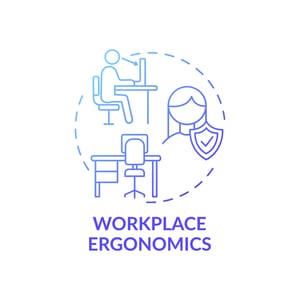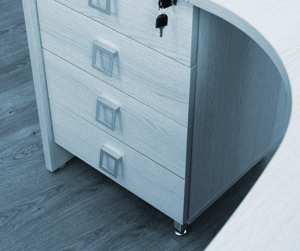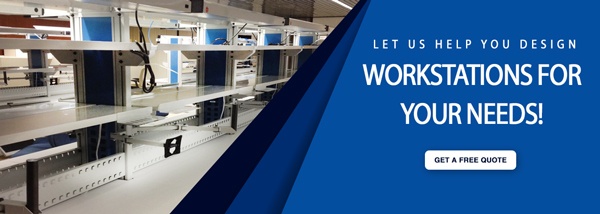Picture a space where every tool has a designated home, where clutter doesn’t exist, and where productivity and organization reign supreme. While this may seem like a fairytale in many work environments, this ideal workspace can be achieved. And even better, it can benefit the health of your employees.
Studies show a connection between the design of our workspaces and the well-being of employees. While having an organized space can make us all more productive, it can also have the power to influence employee health in profound ways.
After all, we spend a significant portion of our lives at work, and research has shown that optimized workspaces can reduce stress levels, improve concentration and enhance physical comfort … leading to reduced workplace injuries.
While you’ll find many pieces of equipment and industrial furniture throughout a workspace setting, a workbench is one of the most common and where employees spend a great deal of their days. Selecting work benches with drawers for your environment isn’t only about organization … it is an important decision that can have far-reaching impacts.
The Importance Of Ergonomics In The Workspace
Workplace injuries can occur due to a number of factors, from accidents to unsafe working conditions, inadequate training, equipment malfunction, failure to follow proper safety protocols and simply human error.
inadequate training, equipment malfunction, failure to follow proper safety protocols and simply human error.
Some of the most recent workplace data from the U.S. Bureau of Labor Statistics show that in 2019, more than 285,000 private industry workers went to the emergency room after a nonfatal injury or illness occurred at work. This accounted for just over 32% of all private sector incidents that resulted in days away from work.
Of these injuries, more than 47,000 were due to musculoskeletal disorders, or ergonomic injuries.
Ergonomic injuries result from repetitive strain, awkward postures or overexertion in the workplace. These injuries typically affect the muscles, tendons, ligaments, nerves or other soft tissues of the body, particularly in areas like the back, neck, shoulders, wrists and hands. Common examples of ergonomic injuries include carpal tunnel syndrome, tendonitis, back pain, neck strain, and rotator cuff injuries.
Poor ergonomics, such as improper industrial workbench setup, prolonged sitting or standing, heavy lifting, repetitive motions and lack of rest breaks, can contribute to the development of ergonomic injuries.
How Ergonomic Injuries Impact Your Business
When a worker sustains an ergonomic injury, your business can be impacted as well.
Ergonomic injuries can limit an employee’s ability to perform tasks efficiently, resulting in decreased productivity. Employees with ergonomic injuries may require time off work to recover or seek medical treatment as well. This can lead to increased absenteeism, leaving businesses short-handed, which can then affect project timelines or service delivery.
You may also have to worry about higher healthcare costs. Ergonomic injuries may require further medical attention like doctor visits, diagnostic tests, physical therapy or even surgeries. These healthcare costs can add up, especially if workers’ compensation claims or insurance premiums are involved, impacting a business’s expenses.
When your other employees see their co-workers experiencing ergonomic injuries, this can negatively impact the overall morale and job satisfaction of your workplace. Overall team dynamics can feel different, as can the level of employee engagement.
You may also see an increase in training and replacement costs. When workers sustain injuries and cannot return to their roles or require a prolonged absence, you may need to hire temporary or permanent replacements. Retraining or modifying job tasks to accommodate injured workers’ limitations can come with additional costs.
In a serious scenario from a business’s financial perspective, you may face potential legal consequences. If your business fails to provide a safe and ergonomically-sound work environment, you may be held liable for a worker’s injury. This can lead to legal repercussions, fines or compensation claims, resulting in financial losses for your company.
Creating Ergonomically-Friendly Work Benches With Drawers
One of the first places you can create an ergonomically-friendly workspace is with the work benches in your facility. Workers often spend several hours at these workstations, making them the first logical place to improve.
your facility. Workers often spend several hours at these workstations, making them the first logical place to improve.
Here are some of the areas of a work bench you can focus on during the design process.
Adjustable Height
An adjustable height workbench allows the user to lift or lower it based on the user’s height or whether the person prefers sitting or standing.
There are several different types of adjustable workbenches, including slot adjustment, hand crank, hand crank with hydraulic features, and electric.
A slot adjustment bench allows a worker to make adjustments by raising the work table legs and removing bolts or spacers. A hand crank workbench is also manual in design, but allows employees to rotate a hand crank to lift or lower the bench. A hand crank makes the process easier for workers, but if there are heavy objects on the bench, it may be difficult to raise and lower the worksurface.
The hand crank workbench with hydraulic features uses hydraulic fluid in the cylinders to force the shafts in the adjustable workbench legs to elevate. This pressure that lowers or lifts the work surface makes the process easier, especially with heavy-duty workbenches that hold heavy loads.
An electric adjustable height workbench provides the highest level of ergonomic support because an employee can lift or lower the surface with the simple push of a button. If there are heavy work tools on the bench, a bench with an electrical component will also require less physical effort to raise the bench than hand cranking the bench. Depending on the model, you may be able to preset positions for convenience as well.
Drawer Design
Ergonomically-designed drawers help optimize the workspace because they prevent repeated strains to the body. An ergonomically-friendly design offers a higher level of accessibility, allowing workers to have contact with the drawers without having to unnaturally reach for them.
You will also need to consider how you configure the drawers based on your workers’ needs. For example, when examining different work benches with drawers, within the same amount of space, you can fit four 3-inch drawers and two 6-inch drawers, eight 3-inch drawers, or four 3-inch drawers and one 12-inch drawer.
How Your Workspace Is Arranged
How a workspace’s lab supplies or tools are arranged and stored can impact an employee’s ergonomic health as well. For example, monitor holders permit the easy movement of computer monitors to keep them at correct eye level for different employees in shared workspaces.
Keyboard trays help to ensure employees’ shoulders and wrists are in the correct position when typing or using a mouse, while shelving and bins allow employees to have power tools, parts, accessories and other products close at hand. Document storage holders can also keep necessary files, folders, instructions and other items within easy reach.
Items like electrical strips, power outlets, USB ports and emergency power sources can be strategically placed on or around the workbench to create a highly organized space and permit easy access to these important pieces.
A Comfortable Chair For Sitting
It’s easy to overlook the importance of a comfortable chair for sitting at work benches. Ergonomically-supportive chairs should always have:
- Sturdy frames
- Adjustable height capabilities
- Comfortable backrests and seats
Industrial furniture chairs should always support employees’ posture and comfort, which will then impact their productivity and safety in a positive way.
A Proactive Approach To Ergonomics
By taking a proactive approach to ergonomics, you can help to ensure that the design of your work benches with drawers is supportive, comfortable and created with productivity in mind.
Ergonomic injuries can have a significant impact on your business, affecting employee well-being, as well as your financial stability and legal obligations. By taking the steps to create a healthier and more productive work environment, you can create a space that allows employees to thrive.
Design isn’t merely about aesthetics. It’s about nurturing employee health and fostering a positive work culture.


